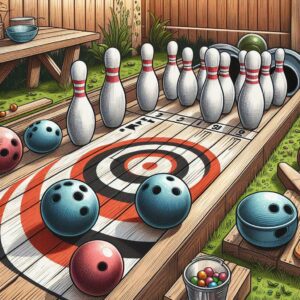Rolling your own balls down the wooden lanes at home is every serious bowler’s dream, and is more realistic than you might think. With an ambitious budget and enthusiasm for the sport, building out your own bowling alley in your residence is entirely achievable—albeit a major investment.
In this guide, I will provide a full breakdown of what it takes to install a custom bowling lane system in your home. I will outline typical home bowling alley costs, considerations, preparation steps, sourcing the equipment and installation, additional amenities to include if budget allows, and tips to maximize your enjoyment and value from your home’s new premium entertainment feature.
Let’s get rolling with the fundamentals first to lay the groundwork! The average home bowling alley dimensions follow regulation size: about 60 feet long by 2.5 to 3 feet wide for the lane itself.
This elongated space is flanked by gutters on either side to catch errant balls and prevent potential damage to your home. Quality bowling lane boards are crafted from maple hardwood and layered strategically to be as smooth and perfectly level as possible.
So what does it realistically cost to transform house space into a functional single-lane bowling alley like the pros compete on?
All-in with a full complement of equipment described below plus the structural construction, electrical work, flooring, ventilation and more, most home bowling alley projects run between $30,000 up to $250,000-plus.
Yes, quite the range when it comes to home upgrades! Several key factors determine where your total lands within that spectrum for an ideal custom bowling lane suited to your home, preferences, and budget limitations.
Preparing the Space
Before sourcing fancy specialized gear, you first need an appropriately sized and located space on your property to even house it. This may mean renovating an entire unfinished basement or garage or clearing out a little-used area in your residence with ample length.
Depending on your planned bowling alley positioning, construction costs tally between $5,000 to $50,000+. Skilled contractors must properly create and level the elongated floor space, install electrical outlets and ambient lighting, wire up adequate ventilation, HVAC and dehumidification so conditions stay ideal, and potentially soundproof the area from the rest of your home. These foundational build-out costs stack up rapidly for such niche renovations.
Sourcing Bowling Lane Equipment
Once properly constructed and prepped, it’s time to source the full breadth of essential bowling alley gear to outfit an enjoyable, high-functioning single lane:
Bowling Lane Boards and Gutters
Synthetic lanes with automated features run upwards of $100,000+. For DIY builders working within tighter budgets, genuine maple hardwood boards are an attractive cost-saver at around $10,000 to $20,000.
This includes materials and hiring experienced professionals for proper multi-layer installation overtop the prepared subsurface. The alleys feature visual designs and arrows for aiming purposes. Integrated gutters with ball returns cost several thousand dollars as well.
Automated Pinsetter Machine
No home bowling experience is complete without those satisfying crashing pin sound effects! Fully automated machines that rapidly reset the pins between rolls impress most but cost $15,000+ even when buying secondhand.
Some homeowners opt for semi-automated versions requiring manual pin resetting to save costs. Either way, factor in technicians to handle specialized installation.
Balls and Ball Return System
A quality ball return system will smoothly recirculate balls after each roll. Pair this with a few sets of bowling balls drilled to different finger hole sizes and weights to account for the whole family enjoying your new home upgrade. These two elements combined run $5,000 to $10,000.
Scoring Displays, Lighting, and More
Programmable score-keeping consoles and display screens seamlessly track game progress and stats. Integrate glowing neon accent lighting around lanes and seating areas for that bowling alley ambiance.
Consider storage solutions for house balls, rental shoes, cleaning supplies, and more to keep the space organized. Between these nice-to-have features, allot an additional $5k or more.
When considering this entire spectrum collectively, constructing a standalone regulation-length single bowling lane with automated features, scoring tech, quality flooring, and all necessary gear typically comes out to $30,000 up to $70,000+ on average. Layering in optional amenities and custom finishes sends costs spiraling upwards from there.
Maximizing Space with Optional Features
For homeowners striving for that premium full-service bowling experience straight out of luxury hotels and entertainment venues, investing in additional optional features and square footage is well worth it. Consider these popular bowling alley extras between turns tossing strikes:
Seating Areas and Furnishings
Outfit perimeter walls or space behind the lanes with padded benches, stools, and tables suited for food/drinks. Integrate upholstered chairs or sofas to relax on between turns. Budget at least $2,000 – $5,000 for quality furnishings depending on materials and sizing.
Entertainment Upgrades
Install large monitors or screens at the player end or above seating areas to stream sports, music videos, or display rotating images. Wire up an engaging surround sound system as well to pump up the energy and atmosphere. At $3,000+, AV upgrades kick the enjoyment into high gear.
Food and Beverage Perks
What goes better with bowling than piping hot pizza, wings, and cold drinks? Consider mini fridges, drink coolers, small kitchenettes with sinks, food storage, and even snack vending machines to fuel the fun. Budget a few thousand for specialty furniture, appliances, and installation.
Bathrooms/Lockers
When friends and family visit to enjoy your new home bowling alley for hours on end, having bathrooms, locker rooms, towel storage, and more onsite adds major convenience. Expect construction for these auxiliary rooms to run between $15,000 – $30,000+ for plumbing, utilities, finishes, etc.
For homeowners willing and able to spend $100,000+, even more, elaborate concepts like a regulation-size two-lane setup, lounge spaces, or upstairs viewing balconies are possible to max out the entertainment area vibe. Call in design firms early on for structural help realizing grand visions within your existing home footprint and budget.
The Preparation and Installation Process
Executing a seamless home bowling alley construction and installation project relies first on sourcing reliable specialty contractors for the nuanced work.
Companies like Pinsetter Services Inc. have 60+ years of experience designing and building outstanding residential bowling setups from start to finish. Be sure to collect 3-5 project bids and vet references thoroughly before hiring.
The entire process from approving designs to installing the last finishing touches averages 6-12 months. Addressing foundational structural work, flooring, electrical, and HVAC systems can require permitting and eat up significant lead time before visually recognizable progress even begins!
Source bowling lane boards, automated machines, scoring systems, furnishings, and the like around the halfway mark once major construction nears completion.
Calendar ample time for certified technicians and tradespeople to properly install niche gear like wiring the scoring console, calibrating pinsetters, and leveling lane sections—precision matters big time.
Last but not least, have contractors provide operational guidance and maintenance overview education so you can keep your alley performing properly for years of strikes ahead.
Schedule tune-ups as needed. With precise planning, reliable help, and patience navigating potential construction delays, soon you’ll have your own home bowling oasis ready for endless fun with family and friends.
Maximizing Value from a Home Bowling Alley
Committing ample funds, space, and months of coordination pays off tremendously once your residential bowling alley opens for pins to start crashing.
Consistent access to your own well-equipped lane no matter the weather or pandemic restrictions breeds major enjoyment and convenience for homeowners who love to bowl.
Friends and family will envy the memorable entertainment this impressive renovation fuels for home gatherings like holiday parties, birthday bashes, or Super Bowl watch events.
Consider forming a community bowling club and charging nominal dues for use to offset operating and maintenance costs in a mutually beneficial way.
Some homeowners even rent out their residential bowling alleys hourly for kids’ birthday parties or corporate team-building activities at premium prices to maximize value long-term.
And beyond the sheer entertainment perks of unlimited bowling access, don’t underestimate the value boost such niche luxury amenities add to your home’s resale position when the time eventually comes to sell.
Real estate agents can tout the rarity of an onsite bowling alley as a true differentiator to court buyers willing to pay top dollar for unique entertainment spaces and conversation-starting home features. Not to mention serious bowlers seeking the ultimate dream residence!
The Takeaway on Home Bowling Alley Costs
Constructing even a single-lane set up in your residence with quality regulation features represents a minimum $30,000 investment when said and done. All-in costs can easily exceed $250,000 for spacious multi-lane facilities with luxury amenities integrated seamlessly into existing houses or expansive home additions.
Yet devoted bowling fans agree—the sheer convenience and enjoyment value offsets the costs long-term. Scores of personalized design options exist too, so securing project estimates from reputable contractors helps match prospective homeowners with their ideal layout, size, features, and budget limitations.
Do your research, run projected costs and square footage needs, and carefully plan all facets of construction and specialty equipment sourcing. With upfront diligence and coordination, soon friends and family of all ages can share in strikes, spares, and smiles for years down the bowling lane ahead!
Frequently Asked Questions
Does a bowling alley add value to your home?
Yes, adding a bowling alley can increase a home’s value, especially for luxury properties. It’s a rare, premium amenity that makes homes stand out. Serious bowlers may pay over 10% more for residences with private alleys.
Can you make bowling alley at home?
Yes, with ample space, budget, and construction help to install a lane, gutters, pinsetter plus accessories, you can create a residential bowling alley. Allocating at least 700 square feet for a basic setup is best. Expect costs from $30k to $250k+.
Is owning a bowling alley profitable?
Owning a bowling alley can be profitable, generating over $500,000 annually in the right market at higher price points. But hosting leagues, events, offering food/drinks, pro shops and family attractions helps maximize revenues and offset operating costs for the best ROI.
What are the dimensions of a mini bowling lane?
A miniature bowling lane is typically 25-35 feet long and 1.5 feet wide. The scaled-down size fits better in modest home spaces versus regulation 60-foot lanes. Kids and those with mobility challenges may also find mini lanes more accessible and comfortable to play on.
Why are bowling alleys in basements?
Bowling alleys benefit from basement installation since underground placement adheres better to lane length requirements. The space also already offers large square footage and direct ground access for bringing bulky equipment down. Basements are easier to retrofit versus adding external structures.
Why are bowling prices so high?
Bowling alley expenses like property leases, staffing, insurance, equipment maintenance and energy bills keep pricing high, especially as entertainment centers upgrade tech and amenities to stay competitive. During peak times, some raise rates further to balance demand.
How much space do I need to build a bowling lane?
For a regulation bowling lane, allocate at least 5,500 sq ft for a one lane setup, ideally with 18 foot ceilings to accommodate adequate room for swing technique and some observation seating. This accounts for the 60-foot length plus 15 feet of runoff buffer.
Can you bring your own bowling ball to a bowling alley?
Most bowling alleys do allow customers to bring their own clean bowling balls and shoes to use instead of house balls. Establishments with ball rental profits may charge a small fee to bowl using personal equipment or only during non-league play times.
Can you buy a house bowling ball?
Yes, used house bowling balls from old alleys or those that failed certification for cracks/imperfections can sell for $75 or less online. These offer cost savings for casual home and recreational bowlers not requiring personalized finger hole drilling.





